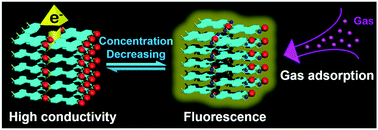Concentration-tailored self-assembly composition and function of the coordinating self-assembly of perylenetetracarboxylate†
Abstract
Perylene derivatives are excellent n-type dyes that display superior potential in optical and electronic materials. Significant efforts have been endeavored toward structural modification of the perylene skeleton. Herein, we showed that the simple coordinating self-assembly of perylenetetracarboxylate could already generate excellent one-dimensional perylene-based self-assembly, and its structural details could be simply tailored by concentration. Microbelts with high potential energy are formed at concentrations below 1 mM, whereas nanobelts with low potential energy appear at higher concentrations. The coordination stoichiometry was 1 : 1 in the microbelt and 1 : 2 in the nanobelt, which resulted in drastic material properties, such that the microbelt with 1 : 1 coordinated PTC and Ni2+ displayed a conductivity 80 times that of the 1 : 2 coordinated nanobelt, whereas the latter exhibited 4 times higher specific surface area, significant fluorescence, and polarized light transmittance. These findings not only unveil a scenario of the coordinating self-assembly of perylenetetracarboxylate, but also show that concentration can act as a powerful tool to tailor the function of self-assembled materials.



 Please wait while we load your content...
Please wait while we load your content...